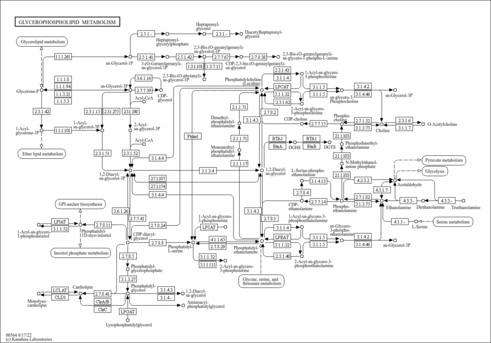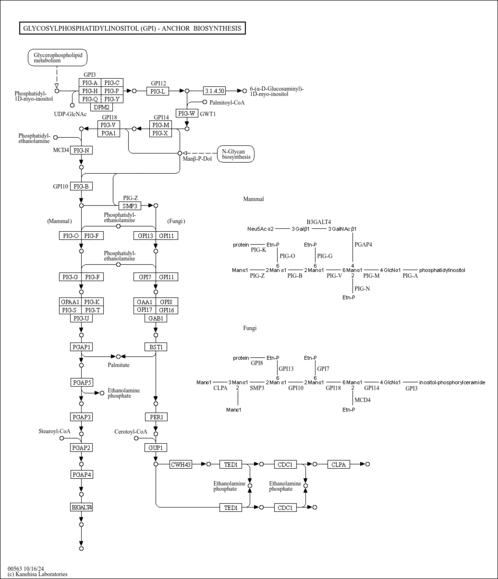| Identification |
|---|
| YMDB ID | YMDB01205 |
|---|
| Name | PE(18:0/16:1(9Z)) |
|---|
| Species | Saccharomyces cerevisiae |
|---|
| Strain | Brewer's yeast |
|---|
| Description | PE(18:0/16:1(9Z)) is a phosphatidylethanolamine (PE or GPEtn). It is a glycerophospholipid in which a phosphorylethanolamine moiety occupies a glycerol substitution site. As is the case with diacylglycerols, glycerophosphoethanolamines can have many different combinations of fatty acids of varying lengths and saturation attached at the C-1 and C-2 positions. Fatty acids containing 16, 18 and 20 carbons are the most common. PE(18:0/16:1(9Z)), in particular, consists of one chain of stearic acid at the C-1 position and one chain of palmitoleic acid at the C-2 position. Phospholipids, are ubiquitous in nature and are key components of the lipid bilayer of cells, as well as being involved in metabolism and signaling.
While most phospholipids have a saturated fatty acid on C-1 and an unsaturated fatty acid on C-2 of the glycerol backbone, the fatty acid distribution at the C-1 and C-2 positions of glycerol within phospholipids is continually in flux, owing to phospholipid degradation and the continuous phospholipid remodeling that occurs while these molecules are in membranes. PEs are neutral zwitterions at physiological pH. They mostly have palmitic or stearic acid on carbon 1 and a long chain unsaturated fatty acid (e.g. 18:2, 20:4 and 22:6) on carbon 2. PE synthesis can occur via two pathways. The first requires that ethanolamine be activated by phosphorylation and then coupled to CDP. The ethanolamine is then transferred from CDP-ethanolamine to phosphatidic acid to yield PE. The second involves the decarboxylation of PS. |
|---|
| Structure | |
|---|
| Synonyms | - (3-Phosphatidyl)-ethanolamine
- (3-Phosphatidyl)ethanolamine
- 1-Acyl-2-acyl-sn-glycero-3-phosphoethanolamine
- 1-stearoyl-2-palmitoleoyl-sn-glycero-3-phosphoethanolamine
- 1,2-diacyl-sn-glycero-3-phosphoethanolamine
- Cephalin
- GPEtn(18:0/16:1)
- GPEtn(18:0/16:1n7)
- GPEtn(18:0/16:1w7)
- GPEtn(34:1)
- O-(1-beta-Acyl-2-acyl-sn-glycero-3-phospho)ethanolamine
- PE(18:0/16:1)
- PE(18:0/16:1n7)
- PE(18:0/16:1w7)
- PE(34:1)
- Phophatidylethanolamine(18:0/16:1)
- Phophatidylethanolamine(18:0/16:1n7)
- Phophatidylethanolamine(18:0/16:1w7)
- Phophatidylethanolamine(34:1)
- Phosphatidylethanolamine
- phosphatidylethanolamines
- 1-Octadecanoyl-2-(9Z-hexadecenoyl)-sn-glycero-3-phosphoethanolamine
- PE(18:0/16:1(9Z))
|
|---|
| CAS number | Not Available |
|---|
| Weight | Average: 717.9964
Monoisotopic: 717.530854925 |
|---|
| InChI Key | XQWOAWVAWAXMKM-UHGNNPBBSA-N |
|---|
| InChI | InChI=1S/C39H76NO8P/c1-3-5-7-9-11-13-15-17-18-20-21-23-25-27-29-31-38(41)45-35-37(36-47-49(43,44)46-34-33-40)48-39(42)32-30-28-26-24-22-19-16-14-12-10-8-6-4-2/h14,16,37H,3-13,15,17-36,40H2,1-2H3,(H,43,44)/b16-14-/t37-/m1/s1 |
|---|
| IUPAC Name | (2-aminoethoxy)[(2R)-2-[(9Z)-hexadec-9-enoyloxy]-3-(octadecanoyloxy)propoxy]phosphinic acid |
|---|
| Traditional IUPAC Name | 2-aminoethoxy((2R)-2-[(9Z)-hexadec-9-enoyloxy]-3-(octadecanoyloxy)propoxy)phosphinic acid |
|---|
| Chemical Formula | C39H76NO8P |
|---|
| SMILES | [H][C@@](COC(=O)CCCCCCCCCCCCCCCCC)(COP(O)(=O)OCCN)OC(=O)CCCCCCC\C=C/CCCCCC |
|---|
| Chemical Taxonomy |
|---|
| Description | belongs to the class of organic compounds known as phosphatidylethanolamines. These are glycerophosphoetahnolamines in which two fatty acids are bonded to the glycerol moiety through ester linkages. |
|---|
| Kingdom | Organic compounds |
|---|
| Super Class | Lipids and lipid-like molecules |
|---|
| Class | Glycerophospholipids |
|---|
| Sub Class | Glycerophosphoethanolamines |
|---|
| Direct Parent | Phosphatidylethanolamines |
|---|
| Alternative Parents | |
|---|
| Substituents | - Diacylglycero-3-phosphoethanolamine
- Phosphoethanolamine
- Fatty acid ester
- Dialkyl phosphate
- Dicarboxylic acid or derivatives
- Organic phosphoric acid derivative
- Phosphoric acid ester
- Alkyl phosphate
- Fatty acyl
- Amino acid or derivatives
- Carboxylic acid ester
- Carboxylic acid derivative
- Organopnictogen compound
- Organic oxygen compound
- Organooxygen compound
- Organonitrogen compound
- Amine
- Primary aliphatic amine
- Organic nitrogen compound
- Primary amine
- Carbonyl group
- Organic oxide
- Hydrocarbon derivative
- Aliphatic acyclic compound
|
|---|
| Molecular Framework | Aliphatic acyclic compounds |
|---|
| External Descriptors | |
|---|
| Physical Properties |
|---|
| State | Solid |
|---|
| Charge | 0 |
|---|
| Melting point | Not Available |
|---|
| Experimental Properties | | Property | Value | Reference |
|---|
| Water Solubility | Not Available | PhysProp | | LogP | Not Available | PhysProp |
|
|---|
| Predicted Properties | |
|---|
| Biological Properties |
|---|
| Cellular Locations | Not Available |
|---|
| Organoleptic Properties | Not Available |
|---|
| SMPDB Pathways | |
|---|
| KEGG Pathways | | Glycerophospholipid metabolism | ec00564 |  | | Glycosylphosphatidylinositol(GPI)-anchor biosynthesis | ec00563 |  |
|
|---|
| SMPDB Reactions | Not Available |
|---|
| KEGG Reactions | Not Available |
|---|
| Concentrations |
|---|
| Intracellular Concentrations | Not Available |
|---|
| Extracellular Concentrations | Not Available |
|---|
| Spectra |
|---|
| Spectra | | Spectrum Type | Description | Splash Key | View |
|---|
| Predicted GC-MS | Predicted GC-MS Spectrum - GC-MS (Non-derivatized) - 70eV, Positive | Not Available | JSpectraViewer | | Predicted LC-MS/MS | Predicted LC-MS/MS Spectrum - 10V, Negative | splash10-014i-0030000900-1d55c34c613ed752ae23 | JSpectraViewer | | Predicted LC-MS/MS | Predicted LC-MS/MS Spectrum - 20V, Negative | splash10-014i-0030000900-1d55c34c613ed752ae23 | JSpectraViewer | | Predicted LC-MS/MS | Predicted LC-MS/MS Spectrum - 40V, Negative | splash10-0uz9-0190300300-17ba9d13223ca070e431 | JSpectraViewer | | Predicted LC-MS/MS | Predicted LC-MS/MS Spectrum - 10V, Positive | splash10-014i-0000010900-6f573d993dec08dd3c88 | JSpectraViewer | | Predicted LC-MS/MS | Predicted LC-MS/MS Spectrum - 20V, Positive | splash10-00or-0003690700-9f2871fa29874bca4f07 | JSpectraViewer | | Predicted LC-MS/MS | Predicted LC-MS/MS Spectrum - 40V, Positive | splash10-004i-0003690300-a87449819311c699e0b7 | JSpectraViewer | | Predicted LC-MS/MS | Predicted LC-MS/MS Spectrum - 10V, Positive | splash10-0006-0000010900-4384bbfae935cffc95d1 | JSpectraViewer | | Predicted LC-MS/MS | Predicted LC-MS/MS Spectrum - 20V, Positive | splash10-0007-0000022900-ad5dbee97cbecdd5b53a | JSpectraViewer | | Predicted LC-MS/MS | Predicted LC-MS/MS Spectrum - 40V, Positive | splash10-0002-0100319100-92cc1db712e5b21d4dc0 | JSpectraViewer | | Predicted LC-MS/MS | Predicted LC-MS/MS Spectrum - 10V, Positive | splash10-014i-0000010900-371a20b1ba3d80b384ee | JSpectraViewer | | Predicted LC-MS/MS | Predicted LC-MS/MS Spectrum - 20V, Positive | splash10-00or-0003690700-e89184f9dea01a79fdc4 | JSpectraViewer | | Predicted LC-MS/MS | Predicted LC-MS/MS Spectrum - 40V, Positive | splash10-004i-0003690300-669f6c1c361b0b712d73 | JSpectraViewer | | Predicted LC-MS/MS | Predicted LC-MS/MS Spectrum - 10V, Negative | splash10-014i-0030000900-4891e765e8769ea0f50d | JSpectraViewer | | Predicted LC-MS/MS | Predicted LC-MS/MS Spectrum - 20V, Negative | splash10-014i-0030000900-4891e765e8769ea0f50d | JSpectraViewer | | Predicted LC-MS/MS | Predicted LC-MS/MS Spectrum - 40V, Negative | splash10-0uz9-0190300300-f840baf0258c45155c7f | JSpectraViewer |
|
|---|
| References |
|---|
| References: | - Ejsing, C. S., Sampaio, J. L., Surendranath, V., Duchoslav, E., Ekroos, K., Klemm, R. W., Simons, K., Shevchenko, A. (2009). "Global analysis of the yeast lipidome by quantitative shotgun mass spectrometry." Proc Natl Acad Sci U S A 106:2136-2141.19174513
|
|---|
| Synthesis Reference: | Not Available |
|---|
| External Links: | |
|---|


